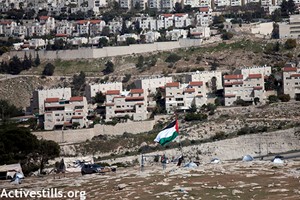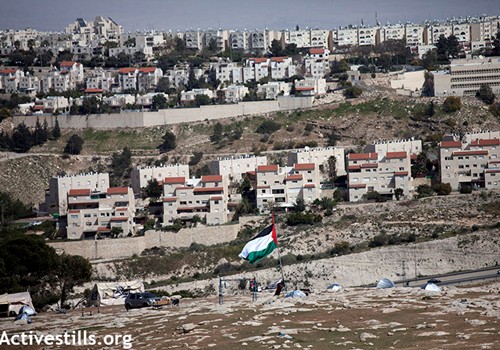
Israel has allocated less than 1 percent of state land in the occupied West Bank to Palestinians, compared to 38% to settlers, daily Haaretz reported last week. The figures cover 33 years and are from Civil Administration documents submitted to the High Court of Justice.
Those documents show that Palestinians received 2,150 acres of state lands during that period, while approximately 99,000 acres were allocated to the World Zionist Organization. Most of the Jewish settlements, both residences and agricultural land, are built on this land. An additional 165,807 acres of West Bank land are still held by the Israeli government.

A huge Palestinian flag is seen opposite the settlement of Ma’ale Adummim in the new protest camp in the E1 area; occupied West Bank, March 21, 2013. The action took place at the same hour Obama landed at Ben Gurion airport near Tel Aviv. On the first day, the Israeli police declared the area a closed military zone (Photo: Activestills)
According to an Adva Center report, updated for 2009 on a per capita basis, Israeli government transfers to the settlements continue to be higher than the average for local authorities within Israel proper, especially in comparison with Jewish development towns, Arab localities and the big cities.
The central government helps finance the activities of municipal governments in two ways: via Balance grants, distributed to local authorities in accordance with set criteria, like the socio-economic level of its residents; and special grants provided for the purpose of decreasing accumulated deficits; and via Service transfers, whose purpose is to finance services provided by the state via the local authorities, like education and social welfare services.
Balance grants were drastically cut in the years 2001-2003; in 2000 they amounted to NIS 3.7 billion and constituted 11% of the total income of the regular budgets of the local authorities, while in 2009 they amounted to NIS 2.1 billion and constituted no more than 5% of local income for regular budgets. In 2009, the settlements received the highest average grant, in the amount of NIS 951 per capita – compared with NIS 303 for Israel proper (without the occupied West Bank and the Golan Heights), NIS 776 for Arab localities, and NIS 616 for Jewish development towns.
Service grants, which totaled NIS 9.2 billion in 2000, were somewhat higher in 2009 – NIS 10.7 billion. The breakdown among different types of localities: NIS 2,264 per capita for the settlements, NIS 1,859 per capita for Arab localities, NIS 1,719 per capita for Jewish development towns, and NIS 1,378 per capita for the big cities.
Prior to 2000, the average per capita allotments of the settlements were much greater. However, in the course of the last decade, the population of the settlements grew at an especially fast rate: between 2000 and 2009, the population of Israel proper grew by 18%, while that of the settlements grew by 47%. The growth rate of the big cities was 12%, Jewish development towns, 10% and Arab localities, 31%. Most of the population growth in the settlements occurred in the ultra-Orthodox settlements: in 2009, Betar Elit and Modi’in Elit accounted for 28% of the total population of the settlements in the occupied West Bank. The same year, those two settlements accounted for 40% of the total number of home construction starts in the settlements.


